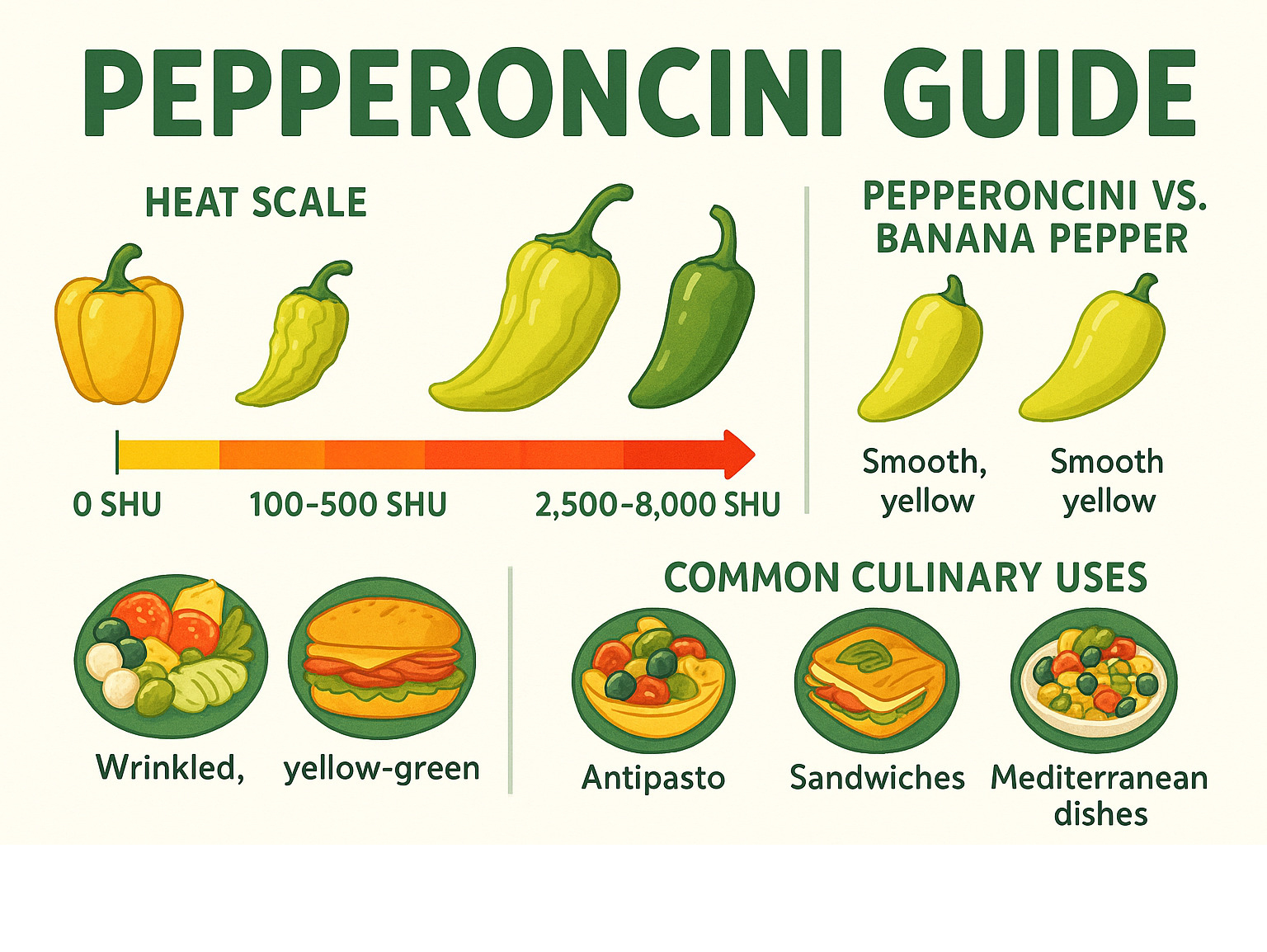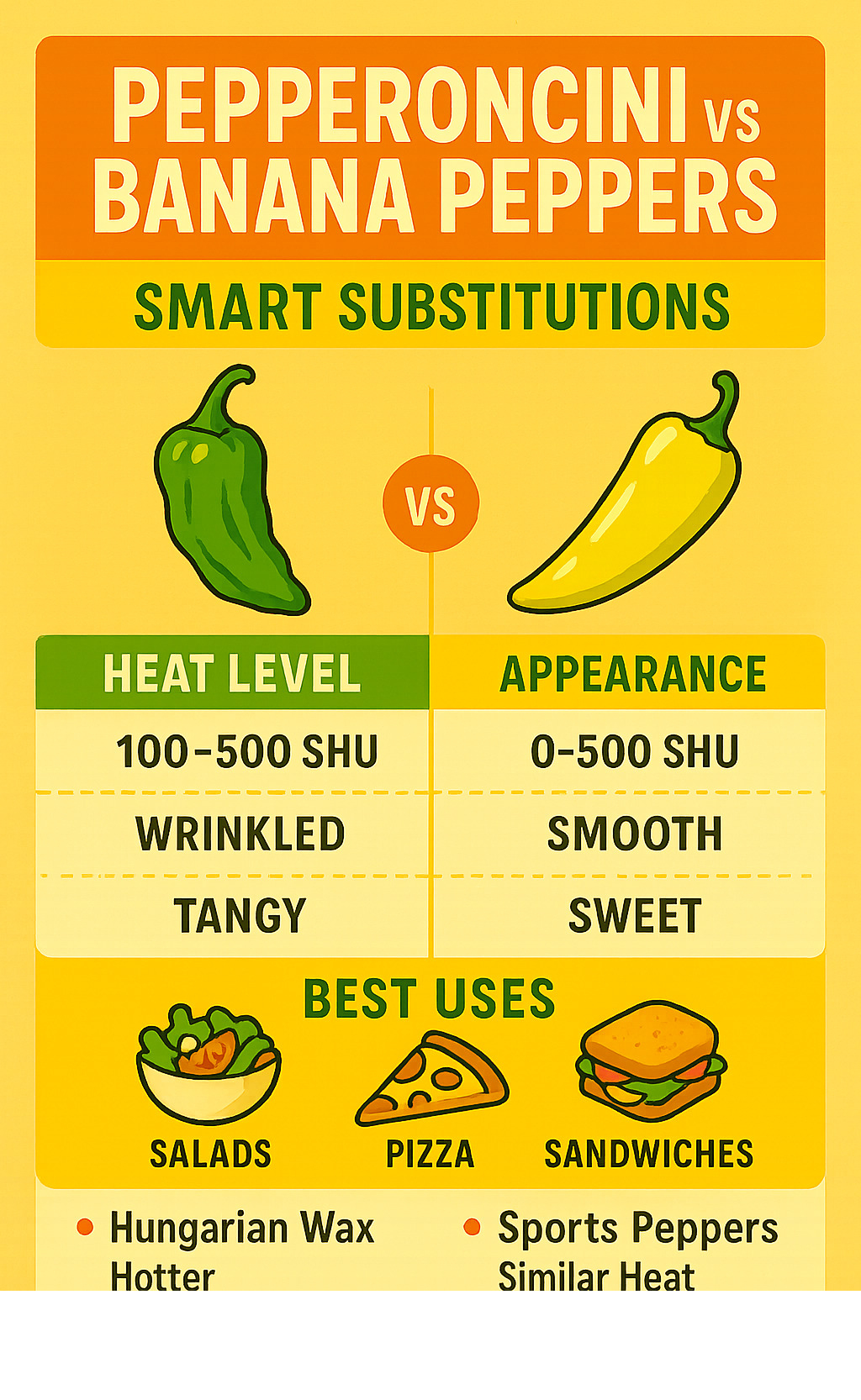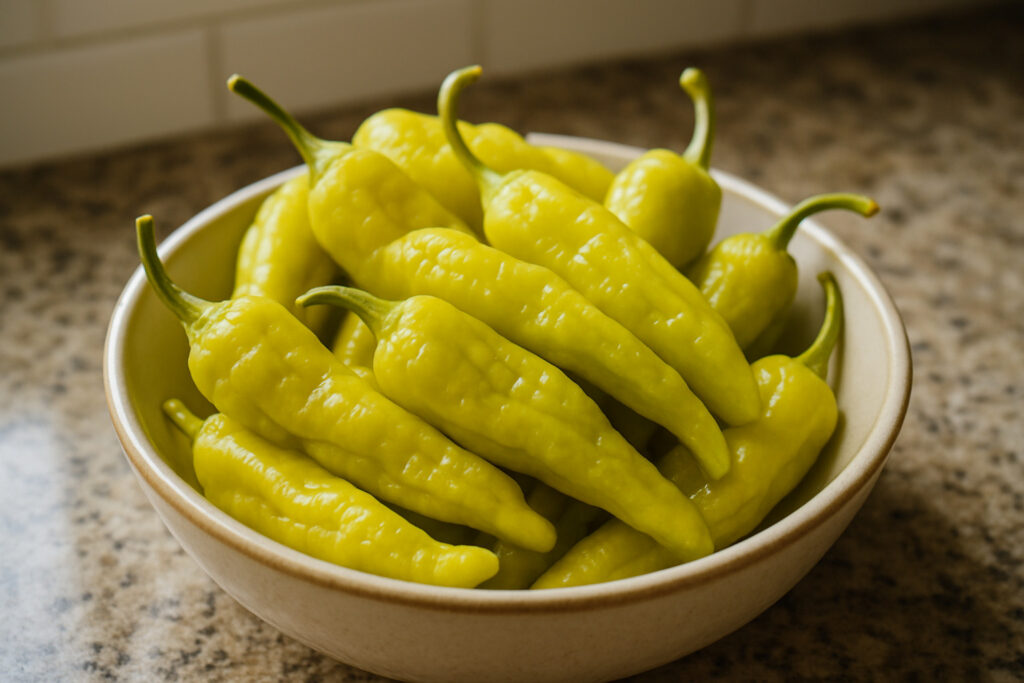Why Pepperoncini Are Every Food Lover’s Secret Weapon
Pepperoncini are mild, tangy Italian chili peppers that pack just enough heat to wake up your taste buds without setting your mouth on fire. These wrinkled, yellow-green gems are the perfect gateway pepper for anyone who wants to add Mediterranean flair to their cooking.
Quick Pepperoncini Facts:
- Heat Level: 100-500 Scoville Heat Units (very mild)
- Flavor: Tangy, slightly sweet with mild heat
- Common Uses: Antipasto platters, sandwiches, salads, pizza toppings
- Pronunciation: “peh-per-uhn-CHEE-nee”
- Also Known As: Tuscan peppers, sweet Italian peppers, golden Greek peppers
If you’ve ever ordered pizza and saved that little pickled pepper for last, you already know pepperoncini. They’re the unsung heroes of Italian-American cuisine – showing up on everything from submarine sandwiches to Greek salads.
What makes pepperoncini special isn’t just their gentle heat. It’s their ability to add brightness and complexity to dishes without overwhelming other flavors. They’re about 50 times milder than jalapeños, making them perfect for adventurous eaters who want to explore peppers without the burn.
For culinary travelers seeking authentic Mediterranean experiences, pepperoncini offer a taste of traditional Italian and Greek cooking that’s been perfected over centuries. Whether you’re recreating dishes from your favorite New York City Italian restaurant or planning your next foodie trip, these versatile peppers deserve a spot in your kitchen.

Similar topics to pepperoncini:
Pepperoncini 101: Origin, Appearance, Heat & Pronunciation
Pepperoncini have quite the travel story! These cheerful little peppers belong to the Capsicum annuum species and originally called Central and South America home. Spanish explorers finded them in the 15th century and thought they were special enough to bring back to Europe – and boy, were they right.
The journey from the Americas to Mediterranean kitchens is a classic tale of the Columbian Exchange. When these peppers first arrived in Italy, people were actually suspicious of them. Like tomatoes, they were considered potentially poisonous and used mainly as pretty decorative plants. It took until the late 17th century for brave Italian cooks to start experimenting with them in the kitchen.
Today, pepperoncini go by several names depending on where you are. Italians call them “peperoncini,” “peperone,” or “friggitello.” Greeks know them as “golden Greek peppers.” Here in the United States, you might see them labeled as “Tuscan peppers” or “sweet Italian peppers” at the grocery store.
Spotting pepperoncini is pretty easy once you know what to look for. They’re about 2-3 inches long with thin, wrinkled yellow-green skin that gives them character. This wrinkled texture is actually what sets them apart from banana peppers, which have smooth, waxy skin. As they ripen, they can turn red, but don’t worry – this doesn’t make them any spicier.
The pronunciation trips up a lot of people, but it’s actually straightforward: “peh-per-uhn-CHEE-nee.” Practice it a few times, and you’ll sound like a pro ordering at your favorite Italian spot.
At 100-500 Scoville Heat Units, pepperoncini are wonderfully mild. Scientific research on capsaicin benefits shows that even gentle peppers like these can boost your health through their capsaicin content, without making you reach for a glass of milk.
History in Mediterranean Cooking
Pepperoncini found their perfect home in Mediterranean cuisine, where cooks have always valued flavor balance over pure heat. Italian kitchens acceptd these peppers as the ideal way to add brightness to dishes without overwhelming other ingredients.
In traditional Italian antipasto platters, pepperoncini play a starring role alongside cured meats, aged cheeses, and briny olives. Their tangy bite cuts through rich flavors and cleanses the palate between bites.
Greek cuisine welcomed pepperoncini with equal enthusiasm. Walk into any authentic Greek restaurant, and you’ll find them nestled in traditional Greek salads with cucumbers, feta cheese, and Kalamata olives. The mild heat and acidic punch from pickling create the perfect flavor balance that makes Greek salads so addictive.
How Spicy Are Pepperoncini?
When it comes to pepperoncini heat, think “gentle tingle” rather than “mouth on fire.” At 100-500 Scoville Heat Units, they’re incredibly approachable for pepper newcomers.
To put this in perspective, bell peppers have zero heat, while jalapeños start at 2,500 SHU – that’s about 50 times hotter than pepperoncini! This makes pepperoncini the perfect gateway pepper for anyone wanting to explore spicy foods without the tears.
The heat level is so mild that most people can enjoy them straight from the jar. They provide just enough warmth to wake up your taste buds and add complexity to dishes, making them ideal for family meals where not everyone loves spicy food.
Nutritional Perks & Health Benefits
You might think of pepperoncini as just a tasty pizza topping, but these little golden gems pack an impressive nutritional punch. With only 10 calories and 2 grams of carbs in a four-pepper serving, they’re proof that good things really do come in small packages.
What makes these peppers particularly exciting from a health perspective is their vitamin C content. Just a small serving provides a significant boost to your immune system and helps your body produce collagen for healthy skin. The vitamin A in pepperoncini supports eye health and keeps your immune system running smoothly, while vitamin E acts as a powerful antioxidant protecting your cells from daily damage.
Don’t overlook the mineral content either. Pepperoncini deliver fiber for digestive health, calcium for strong bones, and iron to help transport oxygen through your bloodstream. It’s like getting a mini multivitamin in pepper form.
Even though pepperoncini are mild, they still contain capsaicin – the compound that gives peppers their heat. Scientific research on capsaicin benefits shows that this natural compound can boost metabolism and support heart health, even at the low levels found in these gentle peppers.
For anyone watching their diet, pepperoncini are remarkably accommodating. They’re keto-friendly with their minimal carb count, and their antioxidant profile helps fight free radicals that can damage cells over time. Whether you’re counting calories or just trying to eat healthier, these peppers make it easy to add flavor without guilt.
Potential Downsides: Sodium in Pickled Jars
Here’s where we need to pump the brakes a bit. While pepperoncini themselves are nutritional superstars, the pickling process adds a significant amount of sodium to the equation. Those four innocent-looking peppers contain about 360 mg of sodium – nearly a quarter of what heart health experts recommend for an entire day.
To put that in perspective, you’re getting more sodium from a small serving of pickled pepperoncini than you’d find in a bag of chips. The culprit is the brine that keeps them tangy and shelf-stable, but it’s definitely something to consider if you’re watching your salt intake.
The good news? You have options. Rinsing pepperoncini before eating removes some of the excess salt, and you can look for low-sodium varieties when shopping. Some brands are responding to health-conscious consumers by offering reduced-sodium options.
If you’re really committed to controlling your sodium intake, consider making your own pickled pepperoncini at home. This way, you can enjoy all the tangy goodness while keeping the salt levels in check. Your heart (and your taste buds) will thank you for finding that perfect balance between flavor and health.
Buying, Storing & DIY Pickling
Finding quality pepperoncini is easier than you might think, and honestly, it’s one of those grocery store trips that can be surprisingly rewarding. Most supermarkets stock jarred pickled pepperoncini in the pickle aisle or tucked away in the Italian foods section – sometimes they’re hiding in both places!
When you’re shopping for jarred varieties, look for peppers that are firm and brightly colored through the glass. Avoid any jars where the peppers look mushy or have dark spots floating around. Trust me, nobody wants a disappointing pepperoncini experience.
Fresh pepperoncini are like finding treasure – they’re not always easy to locate, but when you do, it’s worth celebrating. Your best bet is farmers markets or specialty Italian grocers, especially in areas with strong Italian-American communities. Choose fresh peppers with smooth, unblemished skin and firm texture – they should feel crisp when you gently squeeze them.
For the green-thumbed food lovers out there, growing your own pepperoncini is surprisingly rewarding. These plants are productive and thrive in warm weather, making them perfect for both garden beds and containers. Many home gardeners swear that homegrown pepperoncini taste better than anything you can buy in stores.
The traditional Italian preservation method involves slitting the peppers and hanging them on wires in sunny, well-ventilated areas to dry. While this sounds romantic and authentic, most of us prefer the convenience of pickling, which keeps that crisp texture and tangy flavor we love.
For those wanting to dive deeper into pepper varieties and growing tips, this comprehensive guide offers excellent insights: Pepperoncini Peppers – All About Them.
Step-by-Step Quick Pickle Guide
Making your own pickled pepperoncini is one of those kitchen projects that makes you feel like a culinary genius, even though it’s surprisingly simple. Plus, you get to control the salt content and customize flavors to your heart’s content.
Here’s what you’ll need: 1 pound fresh pepperoncini, along with 1 cup each of white vinegar and water. For the brine, grab 2 tablespoons salt, 1 tablespoon sugar, 3 garlic cloves, 2 bay leaves, and 1 teaspoon black peppercorns.
Start by washing and drying your peppers thoroughly. Using a sharp knife, make a small slit lengthwise in each pepper – this helps the brine penetrate and prevents the peppers from floating like little green balloons.
Pack the peppers into clean mason jars along with the garlic, bay leaves, and peppercorns. Don’t be shy about cramming them in – they’ll shrink slightly as they pickle.
In a saucepan, combine the vinegar, water, salt, and sugar. Bring this mixture to a rolling boil, stirring until the salt and sugar completely dissolve. The kitchen will smell amazing at this point.
Pour the hot brine over the peppers, leaving about 1 inch of headspace at the top. Seal the jars and let them cool to room temperature before refrigerating.
The hardest part? Waiting at least 3 days before tasting them. Trust the process – the flavor development during those first few days is magical.
Storage Cheat-Sheet
Proper storage keeps your pepperoncini tasting their best and, more importantly, safe to eat. Here’s everything you need to know without getting overwhelmed.
Unopened jars are wonderfully low-maintenance. Store them in a cool, dark pantry away from heat sources, and they’ll happily sit there for 2-3 years. Just remember to check expiration dates during your occasional pantry cleanouts.
Once you crack open a jar, things change. Always refrigerate opened pepperoncini and keep those peppers submerged in their brine – it’s their protective blanket. They’ll maintain quality for 4-6 months in the fridge, though they rarely last that long in most kitchens.
Fresh pepperoncini need different care. Store them in your refrigerator’s crisper drawer and use them within 1-2 weeks. Don’t wash them until you’re ready to use them – moisture is fresh peppers’ enemy.
Watch for spoilage signs like musty odors, slimy texture, mold growth, or cloudy brine in pickled varieties. When in doubt, throw them out. Your taste buds and stomach will thank you for being cautious.
Cooking with Pepperoncini: Dishes, Pairings & Recipes
Pepperoncini are the secret ingredient that transforms ordinary dishes into something special. Their gentle heat and bright, tangy flavor make them incredibly versatile – whether you’re recreating the antipasto platter from your favorite New York City Italian restaurant or experimenting with fusion cuisine at home.
The beauty of pepperoncini lies in their ability to add complexity without overwhelming other flavors. They’re more tangy than spicy, with a subtle sweetness that plays well with both rich and light dishes. Their pickled nature brings acidity to the table, which brightens heavy foods and balances rich flavors beautifully.
Classic applications showcase why pepperoncini have been Mediterranean kitchen staples for centuries. They’re absolutely essential on antipasto platters, where their bright tang cuts through rich cured meats and creamy cheeses. In Greek salads, they provide the perfect acidic punch alongside cucumbers, feta, and olives. And let’s not forget their starring role in sandwiches and subs – that satisfying crunch and zing that makes every bite more interesting.
But pepperoncini really shine when you get creative with them. Mississippi pot roast has become a modern classic, where the peppers and their brine slowly infuse the beef with incredible flavor. They make an unexpected but delicious Bloody Mary garnish, adding savory complexity to the cocktail. On pizza, they scatter beautifully over the cheese, adding pops of flavor and color.
For neat entertaining, try them on burrata boards where their acidity balances the creamy cheese perfectly. They also add a wonderful twist to Chicken Milanese, bringing brightness to the rich, breaded cutlet. Mixed with Greek yogurt, chopped pepperoncini create a fantastic spicy yogurt dip that’s perfect for vegetables or pita chips.
The key to cooking with pepperoncini is understanding their flavor profile. They pair beautifully with capers and olives, creating that classic Mediterranean flavor combination. Fresh herbs like oregano and basil complement them perfectly, while their acidity makes them excellent in grain salads where they cut through the earthiness of farro or quinoa.
If you’re looking to expand your Italian cooking repertoire, pepperoncini work wonderfully in many dishes. Check out our chicken recipes for ideas on incorporating these versatile peppers into your cooking trips.

Pepperoncini vs Banana Peppers & Smart Substitutions
One of the most common questions we hear about pepperoncini is how they compare to banana peppers. While grocery stores often use them interchangeably, there are distinct differences that matter when you’re cooking.
Pepperoncini always have some heat (100-500 SHU), while banana peppers can be completely mild (0-500 SHU). This means pepperoncini provide consistent flavor, while banana peppers can be unpredictable. Visually, pepperoncini have wrinkled, thin skin and an irregular, curved shape, while banana peppers are smooth, waxy, and straight with pointed tips.
The flavor difference is significant too. Pepperoncini are tangy with a slightly bitter edge, while banana peppers lean sweet and mild. This makes pepperoncini better for dishes where you want that acidic punch, while banana peppers work better when you want sweetness without heat.
| Feature | Pepperoncini | Banana Peppers |
|---|---|---|
| Heat Level | 100-500 SHU (always some heat) | 0-500 SHU (can be completely mild) |
| Appearance | Wrinkled, thin skin | Smooth, waxy skin |
| Shape | Curved, irregular | Straight, pointed tip |
| Flavor | Tangy, slightly bitter | Sweet, mild |
| Origin | Italy/Greece | Hungary |
When substituting, consider what you want from the dish. Use banana peppers when you want sweetness without heat – they’re perfect in salads where you want pepper flavor without any bite. Choose pepperoncini when you want tang and consistent mild heat, especially in Mediterranean dishes or anywhere you need that acidic brightness.
For other substitutions, Hungarian wax peppers offer similar appearance but much more heat (5,000-15,000 SHU). Sports peppers provide similar size and heat levels and are popular in Chicago-style dishes. If you can’t find either, pickled jalapeños work in a pinch, though they’re much hotter and will change the dish’s character significantly.

Five Beginner-Friendly Recipes
These pepperoncini recipes are perfect for home cooks who want to explore Mediterranean flavors without complicated techniques or hard-to-find ingredients.
Greek salad is the perfect starting point – combine cucumbers, tomatoes, red onion, feta cheese, and olives with whole pepperoncini. Dress simply with olive oil, lemon juice, and oregano. The pepperoncini provide that authentic tangy bite that makes the difference between a good Greek salad and a great one.
Slow-cooker pepperoncini beef has become a modern comfort food classic. Place a chuck roast in your slow cooker with an entire jar of pepperoncini, including the juice, plus ranch dressing mix and au jus mix. Cook on low for 8 hours, and you’ll have incredibly tender, flavorful beef that’s perfect for sandwiches or over rice.
Antipasto pasta salad brings together the best of Italian flavors in one dish. Toss cooked pasta with chopped pepperoncini, salami, mozzarella, olives, and Italian dressing. The pepperoncini add brightness that cuts through the rich meats and cheese, making it perfect for picnics or potlucks.
Spicy yogurt dip is surprisingly addictive and incredibly easy. Mix Greek yogurt with chopped pepperoncini, minced garlic, fresh herbs, and a drizzle of the pepper brine. Serve with vegetables or pita chips for a healthy appetizer that has just enough kick to keep people coming back.
Roasted vegetables with pepperoncini vinaigrette lifts simple roasted vegetables into something special. Roast your favorite vegetables, then dress them with a vinaigrette made from pepperoncini brine, olive oil, and herbs. The acidity brightens the caramelized vegetables beautifully.
Each recipe showcases how pepperoncini can transform simple ingredients into something memorable, proving that you don’t need exotic ingredients to create exciting flavors.
Frequently Asked Questions about Pepperoncini
How do you pronounce “pepperoncini”?
The correct pronunciation is “peh-per-uhn-CHEE-nee” – think of it as “pepper” plus “uhn-chee-knee.” The emphasis falls on that final “CHEE” syllable, which gives it that authentic Italian sound.
Don’t feel embarrassed if it takes a few tries to get it right! Even seasoned food lovers sometimes stumble over this one. We’ve heard everything from “pepper-own-CHEE-nee” to “pepper-con-CHEE-nee” in restaurants. The key is remembering that middle “uhn” sound – it’s what separates the pros from the beginners.
Once you’ve got it down, you’ll sound like you know your way around an Italian kitchen. And trust us, your server at that authentic Italian place will definitely notice.
Do they need refrigeration after opening?
Yes, always refrigerate pepperoncini after opening the jar. This is one of those food safety rules you don’t want to skip, even though the acidic brine might make them seem shelf-stable.
The pickling brine does help preserve them, but once you’ve broken that seal, refrigeration becomes essential for both food safety and maintaining their crisp texture. Nobody wants mushy pepperoncini on their antipasto platter!
Properly stored in the refrigerator, your opened jar will stay fresh for 4-6 months. Just make sure to keep the peppers submerged in their brine – that’s their protective blanket. If you notice the liquid level getting low, you can top it off with a bit of the brine from a fresh jar.
Can I substitute banana peppers in any recipe?
In most cases, absolutely! Banana peppers and pepperoncini can be swapped in recipes, though you’ll notice some flavor differences. It’s like choosing between two cousins – they’re related, but each has their own personality.
Use banana peppers when you want more sweetness and less tang. They’re perfect for dishes where you want the pepper flavor without any heat at all. Think creamy pasta salads or delicate fish dishes where you don’t want competing flavors.
Stick with pepperoncini when you want that characteristic tangy bite and consistent mild heat. They’re irreplaceable in authentic Greek salads or when you’re making that famous Mississippi pot roast – the slight heat and acidity are what make those dishes sing.
The main thing to remember is that banana peppers can be completely mild, while pepperoncini always pack at least some gentle heat. So if you’re cooking for someone who’s particularly sensitive to spice, banana peppers might be the safer choice.
Conclusion
Pepperoncini truly are the gateway to exploring the wonderful world of peppers. With their gentle heat and bright, tangy flavor, they prove that you don’t need to endure a fiery burn to enjoy complex, satisfying taste.
These humble yellow-green peppers have earned their place as kitchen staples for good reason. They’re versatile enough to lift everyday dishes like sandwiches and salads, yet sophisticated enough to grace traditional Mediterranean antipasto platters. Whether you’re a cautious cook just beginning to experiment with peppers or an adventurous home chef seeking authentic flavors, pepperoncini deliver every time.
What makes pepperoncini special isn’t just their mild heat – it’s their ability to connect us to global flavors and culinary traditions. From the busy Italian markets of New York City to the sun-soaked tavernas of Greece, these peppers carry the essence of Mediterranean cooking into your home kitchen.
The beauty of pepperoncini lies in their approachability. You can start simple – adding a few to your next sandwich or pizza – then gradually explore more adventurous applications like homemade pickling or slow-cooked Mississippi pot roast. Each jar opens up new possibilities for creating memorable meals.
At The Dining Destination, we believe that understanding ingredients like pepperoncini is key to open uping authentic culinary experiences. These peppers represent everything we love about food exploration – they’re accessible, flavorful, and deeply rooted in tradition, yet perfect for modern creative cooking.
Ready to start on your pepperoncini journey? Start with a jar from your local grocery store, try our beginner-friendly recipes, and find why these wrinkled little peppers have captured hearts (and taste buds) worldwide. Your culinary trips are just beginning.
For more Mediterranean inspiration and Italian favorites that pair beautifully with pepperoncini, explore our stromboli guide and other authentic recipes that bring global flavors to your table.








